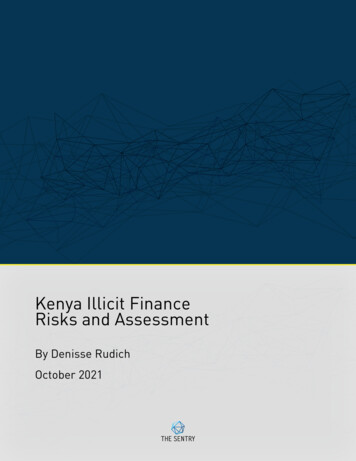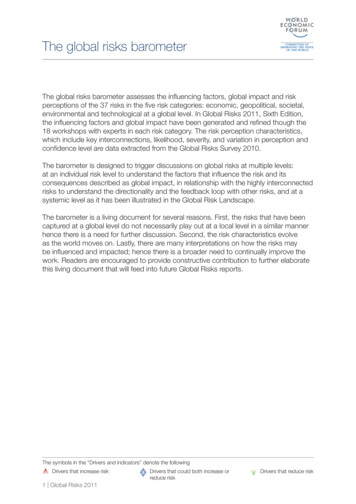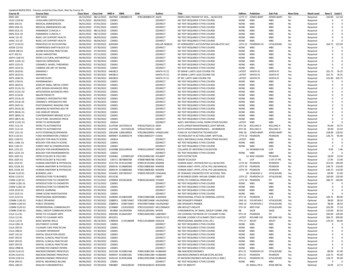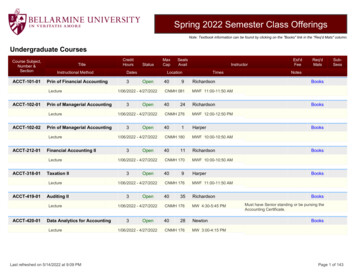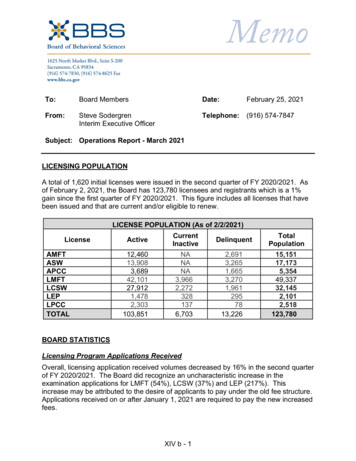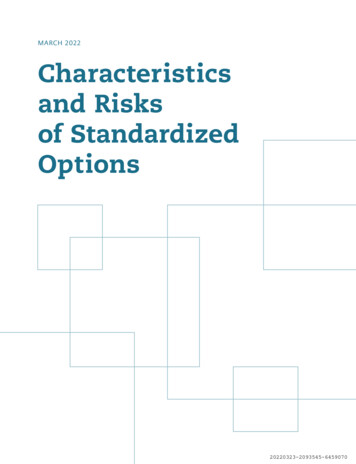
Transcription
MARCH 2022Characteristicsand Risksof StandardizedOptions20220323-2093545-6459070
BOX EXCHANGE LLCNASDAQ BX, INC101 Arch Street, Suite 601Boston, Massachusetts 021102929 Walnut StreetPhiladelphia, Pennsylvania 19104CBOE BZX EXCHANGE, INC.NASDAQ GEMX, LLC400 South LaSalle StreetChicago, Illinois 606052929 Walnut StreetPhiladelphia, Pennsylvania 19104CBOE C2 EXCHANGE, INC.NASDAQ ISE, LLC400 South LaSalle StreetChicago, Illinois 60605CBOE EDGX EXCHANGE, INC.400 South LaSalle StreetChicago, Illinois 60605CBOE EXCHANGE, INC.400 South LaSalle StreetChicago, Illinois 60605MIAMI INTERNATIONALSECURITIES EXCHANGE, LLC7 Roszel Road, Suite 1APrinceton, NJ 08540MIAX EMERALD, LLC7 Roszel Road, Suite 1APrinceton, NJ 08540MIAX PEARL, LLC7 Roszel Road, Suite 1APrinceton, NJ 085402929 Walnut StreetPhiladelphia, Pennsylvania 19104NASDAQ MRX, LLC2929 Walnut StreetPhiladelphia, Pennsylvania 19104THE NASDAQ OPTIONS MARKET LLC2929 Walnut StreetPhiladelphia, Pennsylvania 19104NASDAQ PHLX LLC2929 Walnut StreetPhiladelphia, Pennsylvania 19104NYSE AMERICAN OPTIONS11 Wall StreetNew York, NY 10005NYSE ARCA, INC.11 Wall StreetNew York, NY 10005 2022 BOX EXCHANGE LLC, CBOE BZX EXCHANGE, INC., CBOE C2 EXCHANGE, INC., CBOE EDGX EXCHANGE, INC., CBOE EXCHANGE, INC.,MIAMI INTERNATIONAL SECURITIES EXCHANGE, LLC, MIAX EMERALD LLC, MIAX PEARL LLC, NASDAQ BX, INC., NASDAQ GEMX, LLC,NASDAQ ISE, LLC, NASDAQ MRX, LLC, THE NASDAQ OPTIONS MARKET LLC, NASDAQ PHLX LLC, NYSE AMERICAN OPTIONS, NYSE ARCA, INC.,AND THE OPTIONS CLEARING CORPORATION. All rights reserved.20220323-2093545-6459070
ContentsChapter I — Introduction. 3Chapter II— Options Nomenclature. 6Chapter III— Options on Equity Securities. 18Features of Stock Options.18Chapter IV— Index Options. 24About Indexes.24Stock Indexes.24Dividend Indexes.26Variability Indexes.26Strategy-Based Indexes.28Relative Performance Indexes.29Foreign Currency Indexes.30Information Concerning Underlying Indexes.31Features of Index Options.32Adjustment of Index Options.33Chapter V—Debt Options and Credit Default Options. 35Rates, Yields and Prices of Debt Securities.35Treasury Securities.36Yield-Based Options.37Options on Conventional Index-Linked Securities.38Credit Default Options and Credit Default Basket Options. 40Adjustment of Credit Default Options.41Chapter VI—Foreign Currency Options. 44Market for Foreign Currencies. 44Special Characteristics of Foreign Currency Options.45Special Features of Dollar-Denominated Foreign Currency Options.45Non-Rate-Modified Cash-Settled Foreign Currency Options. 46Cross-Rate Foreign Currency Options.47Special Features of Cross-Rate Options. 48Cash-Settled Foreign Currency Options.49Rate-Modified Cash-Settled Foreign Currency Options.5020220323-2093545-6459070
Chapter VII — Flexibly Structured Options. 52Special Features of Flexibly Structured Options.52Chapter VIII — Exercise and Settlement. 54How to Exercise.54Assignment.55Settlement.55Chapter IX — Tax Considerations, Transaction Costs and Margin Requirements.57Tax Considerations.57Transaction Costs.57Margin Requirements.57Chapter X — Principal Risks of Options Positions. 59Risks of Option Holders.60Risks of Option Writers.62Other Risks.66Special Risks of Index Options.69Special Risks of Debt Options.75Special Risks of Foreign Currency Options.78Special Risks of Flexibly Structured Options.81Special Risks of Credit Default Options.81Special Risks of Binary Options (Other Than Credit Default Options).83Special Risks of Range Options. 84Chapter XI — Scope and Limitations of This Document. 86Notice of Current Amendment (March 2022). 89List of Supplements. 9220220323-2093545-6459070
CHAPTER IIntroductionThis document relates solely to options issued by The Options Clearing Corporation (OCC), and allreferences to “options” in this document are applicable only to such options. As of the date of thisdocument, options are traded on the United States markets listed prior to the Table of Contents. Inthe future, options may be traded on other markets within or outside the United States. The marketson which options are traded at any given time are referred to in this document as the “optionsmarkets.” Options described in this document are those approved for trading on the options marketsbut may not be actively trading at any given time.OCC is a registered clearing agency, and each U.S. options market is a national securities exchangethat is subject to regulation by the Securities and Exchange Commission (SEC) under the SecuritiesExchange Act of 1934.What is an option? An option is the right to buy or sell a specified amount or value of a particularunderlying interest at a fixed exercise price by exercising the option before its specified expirationdate. An option that gives the right to buy is a call option, and an option that gives a right to sell isa put option. Calls and puts are distinct types of options, and buying or selling of one type does notinvolve the other. Certain special kinds of options may give a right to receive a cash payment if certaincriteria are met.EXAMPLE: An option to buy 100 shares of common stock of the XYZ Corporation at a specifiedexercise price would be an XYZ call option. An option to sell 100 shares of common stock of theXYZ Corporation at a specified exercise price would be an XYZ put option.There are two different kinds of options — physical delivery options and cash-settled options.A physical delivery option gives its owner the right to receive physical delivery (if it is a call), or tomake physical delivery (if it is a put), of the underlying interest when the option is exercised. Acash-settled option (other than a binary option or a range option) gives its owner the right to receivea cash payment based on the difference between a determined value of the underlying interest at thetime the option is exercised and the fixed exercise price of the option. A cash-settled call conveys theright to receive a cash payment if the determined value of the underlying interest at exercise —this value is known as the exercise settlement value — exceeds the exercise price of the option,and a cash-settled put conveys the right to receive a cash payment if the exercise settlement valueis less than the exercise price of the option. Binary options and range options are special kinds ofcash-settled options described in Chapter II. The examples in this document generally refer tooptions other than binary options or range options except as otherwise stated.Each options market selects the underlying interests on which options are traded on that market.Options are currently available covering four types of underlying interests: equity securities (whichterm includes “fund shares” described in Chapter III), indexes (including stock, variability, strategybased, dividend and relative performance indexes), debt securities and credit events, and foreigncurrencies. Options on other types of underlying interests may become available in the future.Most options have standardized terms — such as the nature and amount of the underlying interest,the expiration date, the exercise price, whether the option is a call or a put, whether the option isa physical delivery option or a cash-settled option, the manner in which the cash payment and theexercise settlement value of a cash-settled option are determined, the multiplier of a cash-settledoption, the exercise price setting date and exercise price setting formula of a delayed start option, thestyle of the option, whether the option has automatic exercise provisions, and adjustment provisions.These standardized terms are generally described in Chapter II. Each U.S. options market publishesspecification sheets setting forth the particular standardized terms of the options traded on that320220323-2093545-6459070
CHARACTERISTICS AND RISKS OF STANDARDIZED OPTIONSoptions market. (The options markets may also provide for trading in options whose terms are notall fixed in advance. Rather, subject to certain limitations, the parties to transactions in these optionsmay designate certain of the terms. These flexibly structured options are discussed in Chapter VII ofthis document.)Options having the same standardized terms are identical and comprise an options series. Thestandardization of terms makes it more likely that there will be a secondary market on which holdersand writers of options can close out their positions by offsetting sales and purchases. By selling anoption of the same series as the one she bought, or buying an option of the same series as the oneshe wrote, an investor can close out her position in that option at any time there is a functioningsecondary options market in options of that series.In some instances, options of the same series may be traded on more than one options market at thesame time. Options that are so traded are called multiply-traded options. Multiply-traded optionscan ordinarily be purchased and written, and positions in these options can ordinarily be liquidatedin offsetting closing transactions, in any of the options markets in which the options are traded.However, because premiums are affected by market forces, the premiums for identical multiplytraded options may not be the same in all markets at any given time.If an options market learns that a particular underlying interest no longer meets its requirements foroptions trading or is not eligible for trading in all U.S. jurisdictions, or if an options market decidesto discontinue trading in a particular options series for another reason, the options market maystop introducing new options on that underlying interest and may in certain circumstances imposerestrictions on transactions that open new positions in options series that have been previouslyintroduced, although trading in the options series will ordinarily continue on at least one optionsmarket until its expiration.Options generally are traded on U.S. options markets during normal day-time business hours ofU.S. securities exchanges and for a short period afterward. However, trading in options may notbe confined to those hours. Trading in evening and night trading sessions may occur in optionson foreign currencies and may in the future occur in other types of options. Moreover, when there areunusual market conditions, an options market may authorize trading to continue for a substantiallylonger period than under normal conditions. Trading in an expiring option may close at an earliertime than trading in other options. Trading hours for options are also subject to change from timeto time. Readers should ascertain the trading hours of the particular options they are interested intrading from the options markets where those options are traded. Readers should also be aware thattrading in underlying interests is not confined to normal exchange trading hours. For example,underlying foreign currencies and debt securities are traded in international markets on virtuallyan around-the-clock basis, and underlying equity securities may be traded in foreign markets whenU.S. markets are closed and in some U.S. markets after the close of their normal trading hours.Readers should be aware that this document has been written to meet the requirements ofan SEC rule that requires the U.S. options markets to prepare, and brokerage firms to distribute,a document that briefly and generally describes the characteristics of options and the risks toinvestors of maintaining positions in options. Options are versatile instruments that can beused in a wide variety of investment strategies. They give the investor the ability to createpositions that reflect the investor’s opinion of an underlying interest and to select investmentstrategies that reflect the investor’s tolerance for risk. This document is not designed todescribe the various potential benefits of options or how investors may use options toenhance their investment strategies or to reduce risk. Numerous other publications, includingsome prepared by the U.S. options markets that are available upon request, contain discussionsof the uses and potential benefits of options and of the various trading and investment strategiesthat can be employed with options. Readers who wish to balance the general discussion of420220323-2093545-6459070
CHAPTER I: INTRODUCTIONrisks that is contained in this document with a discussion of options uses, benefits and strategiesshould consult one or more of these other publications.Readers should read and understand this document in its entirety, since a number of the separatechapters will be relevant to every reader interested in buying or writing options. For example, a readerwho is interested in options on equity securities should fully read not only Chapter III, but also shouldread Chapters II, VIII and IX, as well as the discussion of risks in Chapter X. Readers should also beaware that, although this document seeks to describe the various characteristics of options and therisks that are unique to being an investor in options, there are many matters which are beyond thescope of this document that are not discussed. Chapter XI contains a discussion of the scope andlimitations of this document.520220323-2093545-6459070
CHAPTER IIOptions NomenclatureThis chapter contains a description of the standardized terms, and of some of the special vocabulary,applicable to options. Most of the nomenclature is the same for options on the various types ofunderlying interests. Differences that are applicable to options on a particular underlying interestwill be described in the chapter devoted to that underlying interest.Certain terms — options, options markets, call options, put options, physical delivery options,cash-settled options, options series, and multiply-traded options — have been defined in Chapter I.Readers interested in those definitions should consult that chapter.OPTION HOLDER; OPTION WRITER — The option holder is the person who buys the right conveyedby the option.EXAMPLE: The holder of a physical delivery XYZ call option has the right to purchase shares of XYZCorporation stock at the specified exercise price upon exercise prior to the expiration of the option.The holder of a physical delivery XYZ put option has the right to sell shares of XYZ Corporation atthe specified exercise price upon exercise prior to the expiration of the option. The holder of a cashsettled option has the right to receive an amount of cash equal to the cash settlement amount(described below) upon exercise prior to the expiration of the option.The option writer is obligated — if and when assigned an exercise — to perform according to theterms of the option. The option writer is sometimes referred to as the option seller. An option writerwho has been assigned an exercise is known as an assigned writer.EXAMPLE: If a physical delivery XYZ call option is exercised by the holder of the option, the assignedwriter must deliver the required number of shares of XYZ common stock. He will be paid for theshares at the specified exercise price regardless of their current market price.If a physical delivery put option is exercised, the assigned writer must purchase the required numberof shares at the specified exercise price regardless of their current market price. If a cash-settledoption is exercised, the assigned writer must pay the cash settlement amount.No certificates are issued to evidence options. Investors look to the confirmations and statementsthat they receive from their brokerage firms to confirm their positions as option holders orwriters. An option holder looks to the system created by OCC’s rules, rather than to any particularoption writer, for performance of the option he owns. Similarly, option writers must perform theirobligations under the OCC system and are not obligated to any particular option holder. Since everyoptions transaction involves both a holder and a writer, it follows that the aggregate rights of optionholders under the system are matched by the aggregate obligations of option writers.The OCC system is designed so that the performance of all options is between OCC and a groupof firms called Clearing Members that carry the positions of all option holders and option writersin their accounts at OCC. To qualify as a Clearing Member, a firm must meet OCC’s financialrequirements. In addition, Clearing Members must provide OCC with collateral for the positions ofoption writers that they carry and must contribute to Clearing Funds that protect OCC against aClearing Member’s failure. The Clearing Members’ guarantees of the performance of options writers’obligations, the financial strength of the Clearing Members, the collateral that they deposit, theobligations of correspondent clearing corporations, and the Clearing Funds together make up theOCC system backing the performance of options.620220323-2093545-6459070
CHAPTER II : OPTIONS NOMENCLATUREEXERCISE PRICE — In the case of a physical delivery option, the exercise price (which is sometimescalled the “strike price”) is the price at which the option holder has the right either to purchase or tosell the underlying interest.EXAMPLE: A physical delivery XYZ 40 call option gives the option holder the right to purchase100 shares of XYZ stock at an exercise price of 40 a share. A physical delivery XYZ 40 put optiongives the option holder the right to sell 100 shares of XYZ common stock at an exercise price of 40 a share.The exercise price of a cash-settled option (other than a binary option or a range option) is the basefor the determination of the amount of cash, if any, that the option holder is entitled to receive uponexercise (see the discussion of “Cash Settlement Amount and Exercise Settlement Value” below). Theexercise price of a binary option is the value or level of the underlying interest above, below, or, insome cases, at which the option will be in the money at expiration, thereby causing the fixed cashsettlement amount to become payable (see the “Binary Option” definition below). In the case of arange option, the exercise price is the option’s range length (see the “Range Option” definition below).Exercise prices for each options series (except for series of delayed start options) are establishedby the options market on which that series is traded at the time trading in the series is introduced,and are generally set at levels above and below the then market value of the underlying interest.However, the options markets may use other methods to set exercise prices. Specific informationregarding the setting of exercise prices may be obtained from the listing options market. The optionsmarkets generally have the authority to introduce additional series of options with different exerciseprices based on changes in the value of the underlying interest, or in response to investor interest, orin unusual market conditions, or in other circumstances. For series of delayed start options, exerciseprice setting formulas — rather than exercise prices — are established by the options market on whicheach series is traded before the time trading commences in each such series. Those exercise pricesetting formulas provide that on the exercise price setting date the exercise price for the series willbe fixed at the money, in the money by a certain amount, or out of the money by a certain amount.EXPIRATION DATE — This is the date on which the option expires. If an option has not beenexercised prior to its expiration, it ceases to exist — that is, the option holder no longer has anyrights, and the option no longer has any value. The expiration dates for the various options seriesare fixed by the options market on which the series trades. Readers should learn the expiration dateof each option they wish to buy or write.STYLE OF OPTION — The style of an option refers to when that option is exercisable. At the dateof this document there are three different styles of options — American-style, European-style andcapped. Subject to certain limitations prescribed in the rules of OCC or the options markets andsubject to applicable law, these three styles are exercisable at the following times:Each American-style option other than a delayed start option may be exercised at any timeprior to its expiration. An American-style delayed start option may be exercised at any time afterits exercise price is set and before its expiration date.A European-style option may be exercised only during a specified period before the optionexpires. Every European-style option being traded at the date of this document is exercisableonly on its expiration date.A capped option will be automatically exercised prior to expiration if the options marketon which the option is trading determines that the value of the underlying interest at aspecified time on a trading day “hits the cap price” for the option. Capped options may also beexercised, like European-style options, during a specified period before expiration. This period720220323-2093545-6459070
CHARACTERISTICS AND RISKS OF STANDARDIZED OPTIONSis the expiration date for all capped options traded at the date of this document. The specialterminology applicable to capped options is discussed at the end of this chapter.European-style or capped options having an expiration period that is longer or shorter than theirexpiration date may be introduced for trading in the future.BINARY OPTION — A binary option is a cash-settled option having only two possible payoff outcomes:either a fixed amount or nothing at all. Some binary options are referred to as “fixed return options.”As of the date this product was approved for trading, the only binary options approved for trading(other than credit default options, as defined below) are binary stock options, which are binaryoptions on individual equity securities, including fund shares; and binary index options, which arebinary options on broad-based securities indexes (including volatility indexes). The binary optionsapproved for trading are all subject to automatic exercise. The holder of a binary option other than acredit default option has the right to receive (and the writer of a binary option has the obligation topay) the exercise settlement amount for the option if the value of the underlying interest as of thetime specified by the applicable listing options market (i.e., the exercise settlement value) meets thecriteria for automatic exercise of the option, as specified in the rules of the listing options market. Ifthose criteria are not met, the option will expire worthless. Credit default options are a specific kindof binary option discussed at the end of Chapter V. Except for credit default options, binary optionsare European-style options.RANGE OPTION — A range option is a European-style, cash-settled option that has a payout if thevalue of the underlying interest falls within a specific range of values (the range length) at expiration.As the underlying interest value increases throughout the range length, the amount of the payout(i.e., the cash settlement amount) of the range option increases linearly to a maximum value, remainsconstant at that value through the middle of the range length and then decreases linearly to zeroas the value of the underlying continues to increase to the top of the range length. A more detaileddescription of this feature of range options is set forth below under the caption “Cash SettlementAmount and Exercise Settlement Value.” Range options are of a single type rather than consistingof puts and calls.UNIT OF TRADING; CONTRACT SIZE — The unit of trading (which is sometimes referred to as thecontract size) of a physical delivery option is the amount of the underlying interest that is subject tobeing purchased or sold upon the exercise of a single option contract. For example, the unit of tradingfor most options on equity securities is 100 shares. Thus, a physical delivery XYZ 50 call will give itsholder the right upon exercise to purchase 100 shares of XYZ at 50 per share. If the option is trading at apremium of, say, 4 per share, then the aggregate premium for a single option contract would be 400.The contract size of a cash-settled option other than a binary option or a range option is determinedby the multiplier that is fixed by the options market on which the options series is traded. Themultiplier determines the aggregate value of each point of the difference between the exercise priceo
Trading hours for options are also subject to change from time to time. Readers should ascertain the trading hours of the particular options they are interested in trading from the options markets where those options are traded. Readers should also be aware that trading in underlying interests is not confined to normal exchange trading hours.




